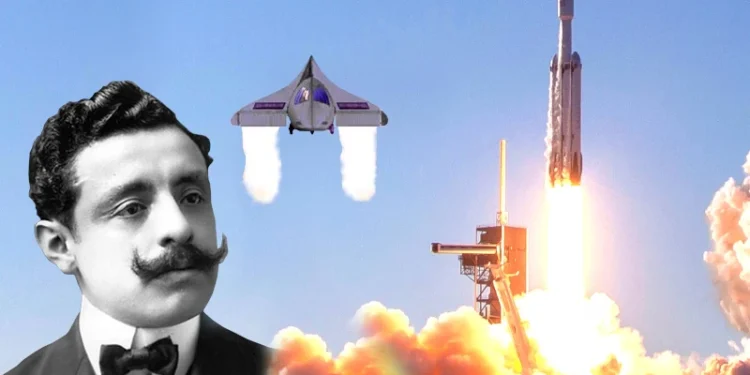This post is also available in:
Español
English
Als het over pioniers in de geschiedenis van de ruimtewetenschap gaat, stelen namen als Wernher von Braun of de gebroeders Wright meestal de schijnwerpers. Weinigen kennen echter het verhaal van een Peruaans genie dat met zijn intellect en creativiteit tientallen jaren anticipeerde op het ruimtetijdperk voordat de mogelijkheid bestond om van de planeet te vliegen. Zijn naam is Pedro Paulet, een multidisciplinaire wetenschapper wiens nalatenschap voortleeft in het hart van de moderne ruimteverkenning. Dit artikel ontrafelt zijn ongelooflijke leven en de bijdragen die hem in de voorhoede van de ruimtevaarttechniek hebben geplaatst, een man die, vanuit nederigheid, eropuit ging om de sterren te bereiken.
Wie was Pedro Paulet?
Pedro Paulet Quispe, geboren in Arequipa, Peru, in 1874, was een echte Renaissance-man. Hij was architect, ingenieur, scheikundige, monteur, econoom, geograaf, beeldhouwer, diplomaat, journalist, uitvinder en schrijver. Maar zijn grootste bijdrage aan de mensheid kwam voort uit zijn passie voor de lucht.
Paulet groeide op in een bescheiden gezin en ging naar school aan de San Vicente de Paúl School. Al op zeer jonge leeftijd toonde hij een ongewone interesse in wetenschap en techniek, en zijn honger naar kennis bracht hem ertoe te studeren aan de Universiteit van Parijs, waar hij in 1900 zijn grote prestatie volbracht: de bouw van de eerste raketmotor aangedreven door vloeistof. brandstoffen. Deze motor, die slechts 2,5 kg woog, een druk van 90 kg uitoefende en 300 explosies per minuut produceerde, was de voorloper van de technologie waarmee de mens later op de maan zou kunnen landen.
De raketmotor die de geschiedenis veranderde
The engine designed by Paulet was not only an unprecedented technological feat for its time, but its visionary application in aircraft propulsion placed him ahead of the Wright brothers, who in 1903 made the first airplane flight. In fact, in 1902, Paulet presented a project that astonished the scientific community: a propeller-less metal airplane with delta wings and an ovoid cabin. His ingenuity was so ahead of its time that many did not understand the magnitude of his invention.
Paulets nalatenschap: van de aarde naar de maan
De impact van Paulets ontdekkingen werd niet in de vergetelheid gelaten. NASA erkende zijn invloed op de technologie die jaren later zou worden gebruikt voor ruimtemissies zoals Apollo 11. In 1969, toen de mens eindelijk voet op het maanoppervlak zette, was het werk van Paulet van cruciaal belang voor de ontwikkeling van motoren op vloeibare brandstof die raketten aandreven. ruimte. Tegenwoordig eert een plaquette in het National Air and Space Museum in Washington D.C. zijn nalatenschap en herinnert de wereld aan het genie dat heeft geholpen de mens op de maan te zetten.
Wernher von Braun en de erkenning van een genie
Misschien wel een van de meest fervente bewonderaars van Paulet was de Duitse ingenieur Wernher von Braun, die wordt beschouwd als de vader van de moderne raketten. In zijn boek World History of Aeronautics stelde Von Braun dat Pedro Paulet moet worden beschouwd als de echte pionier van de voortstuwingsmotor met vloeibare brandstof, waarbij hij de impact van zijn experimenten aan het begin van de 20e eeuw erkende. Zijn woorden weerspiegelen het belang van deze Peruaanse uitvinder in de geschiedenis van de ruimteverkenning.

Een leven gewijd aan wetenschap en onderzoek
Ondanks zijn wetenschappelijke prestaties werd Paulet zijn hele leven met moeilijkheden geconfronteerd. In 1941 vergezelde hij de voormalige Peruaanse president Óscar R. Benavides als commercieel adviseur in Argentinië. Daar probeerde hij een Zuid-Amerikaanse luchtvaartindustrie op te richten, maar zijn visie werd destijds niet volledig begrepen. Helaas gingen veel van zijn prototypes en ontwerpen verloren tijdens de politieke onrust van die tijd.
Paulet droomde van de sterren en zette de ideeën in beweging die de mensheid in staat zouden stellen de barrières van de hemel te doorbreken.
Hij stierf op 30 januari 1945 in Buenos Aires en liet een wetenschappelijke erfenis achter die net erkend begon te worden. Ter ere van hem heeft de Peruaanse luchtmacht een mausoleum opgericht op de begraafplaats Presbítero Maestro, waar zijn stoffelijk overschot rust onder een replica van zijn torpedovliegtuig.
Een droom die bij zijn dochter voortduurde
Het visioen van Pedro Paulet stierf niet met hem. Tijdens zijn leven deelde hij zijn passie voor ruimteverkenning met zijn dochter Megan, tegen wie hij zei: “Als je groot wordt en mijn uitvinding werkelijkheid wordt, zullen jij en ik naar de maan reizen. En als ik vanwege mijn leeftijd zou overlijden, zou jij in mijn voetsporen treden. Hoewel hij zijn droom niet meer in vervulling zag gaan, legden zijn bijdragen de basis voor de mens om de ruimte te bereiken.
Pedro Paulet was niet alleen een genie op het gebied van wetenschap en techniek, maar ook een symbool van doorzettingsvermogen en futuristische visie. In een tijd waarin vliegen onmogelijk leek, droomde Paulet van de sterren en lanceerde hij de ideeën waarmee de mensheid de barrières van de lucht zou kunnen doorbreken. Zijn leven en nalatenschap herinneren ons eraan dat talent en passie elk obstakel kunnen overwinnen, zelfs obstakels die onoverkomelijk lijken.
Laat ons uw opmerkingen en meningen achter in het onderstaande gedeelte. Deel dit artikel met je vrienden en familie, zodat meer mensen de ongelooflijke erfenis van dit Peruaanse genie kennen! Vergeet niet je te abonneren op onze pagina om meer te leren over de figuren die hun stempel hebben gedrukt op de geschiedenis van Peru en de wereld.








